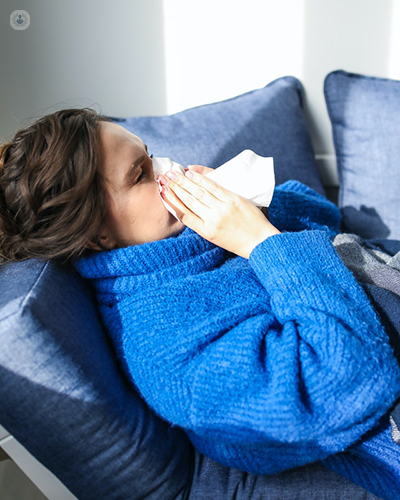Non-allergic rhinitis: An expert guide
Autore:Persistent symptoms of sneezing, a runny nose or itchy eyes are often related to allergies or a viral infection. In some cases, however, the symptoms have a non-allergic and non-infectious cause and require different treatment. In this expert guide, respected consultant ENT surgeon Mr Pavol Surda explains the symptoms and causes of non-allergic rhinitis. The leading specialist also details the diagnostic procedure and treatment options for the condition.

What is rhinitis?
Inferior turbinates are found in the sides of the nose and are covered by a mucous membrane. They act as shelves which enlarge the surface area within the nose. They also help to filter and humidify air as it is breathed in.
Rhinitis, inflammation within the nose, can cause the inferior turbinates to swell up, which narrows the nasal passage. In some cases, the nasal passage can even become completely obstructed. Symptoms of rhinitis usually include:
- breathing difficulties
- excessively runny nose (rhinorrhoea)
- sneezing
- itchy nose
- itchy eyes
What causes rhinitis?
In most cases, viral infections or allergic responses to airborne allergens cause rhinitis. Non-allergic, non-infectious rhinitis can be caused by a number of factors, including:
- exposure to irritants
- exposure to tobacco smoke
- changes in humidity or temperature
- hormonal disorders
- pregnancy
- misuse of some drugs, such as nasal decongestants
- emotional stress
Symptoms which affect the eye or itching are more common in sufferers of allergic rhinitis. However, patients with both allergic and non-allergic rhinitis may experience nasal discharge (runny nose), sneezing and nasal stuffiness.
How is non-allergic rhinitis diagnosed?
When making a diagnosis of non-allergic rhinitis, the doctor will need to establish how severe the condition is and how long the patient has been experiencing symptoms. Possible stimuli will also need to be examined, including:
- any use of medications
- exposure to irritants at work and home
- hormonal status, such as pregnancy, hypothyroidism or acromegaly
- co-existing conditions, such as asthma
In order to make a diagnosis of non-allergic rhinitis and provide effective treatment, the doctor will also need to exclude other conditions which have similar symptoms. A nasal endoscopy can help to exclude a range of nasal diseases. It’s important to also test for allergies and sinus inflammation.
How is non-allergic rhinitis treated?
The best course of treatment for non-allergic rhinitis depends on the extent and duration of the swelling of the inferior turbinates, known as turbinate hypertrophy. In some cases, corticosteroid sprays or tablets may be used to treat rhinitis depending if allergies are present. Surgery, such as a turbinoplasty, may be required if the patient experiences persistent symptoms which cannot be resolved with other types of treatment.
What is involved in surgery for non-allergic rhinitis?
The principal surgical treatment methods for non-allergic rhinitis are:
- coblation turbinoplasty
- endoscopic turbinate reduction
Coblation (controlled ablation) plasma technology is a cutting-edge technique used to treat turbinate hypertrophy in which soft tissue inside the turbinates is both removed and shrunk in order to remove the obstruction within the nasal airway.
It uses a specially designed device which is inserted just below the surface of the enlarged nasal turbinates to allow the doctor to remove and shrink some of the excess tissue. A coblation turbinoplasty can usually be performed as a day-case procedure and patients can usually go home shortly afterwards.
In more severe nasal obstructions, both an enlargement of a bony part of the inferior tubrinates and a swelling of the mucous are often at play. In these cases, a procedure known as microdebrider assisted turbinoplasty may be required. A microdebrider is a specially designed surgical instrument which has a very small, curved tip which helps the surgeon to be more precise. It is used to carefully reduce the size of the inferior turbinates and lowers the risk of removing too much tissue and related complications. Alternatively, special forceps can be used to precisely remove the excess tissue.
What is recovery like following surgery for non-allergic rhinitis?
Although some patients experience slight discomfort in the nose following surgery for non-allergic rhinitis, over-the-counter pain killers are usually adequate to manage this in the days following the procedure. To help minimise bleeding, absorbable foam, gel dressings or nasal sponge packing may be placed inside the nose following surgery.
The nose may feel congested or blocked in the days after the procedure but saline rinses and nasal drops help to relieve this. A small amount of blood or blood-coloured watery liquid may ooze from the nose following the procedure but this is normal. Manual labour, lifting or straining should be avoided until two weeks after surgery.
If you are concerned about the symptoms of non-allergic rhinitis and wish to discuss treatment options, don’t hesitate to schedule a consultation with Mr Surda by visiting his Top Doctors profile.


